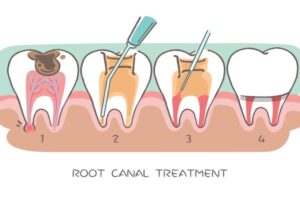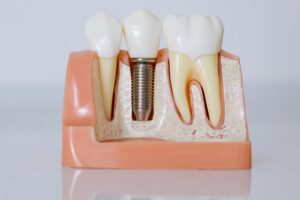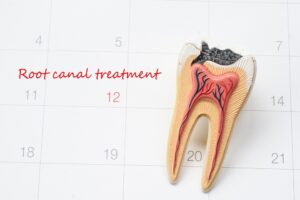Enamels generally wear off in stages when a cavity starts to take shape, so making an early move can keep it from advancing. A tough and mineralized covering, tooth enamel safeguards your mash and dentin – the delicate inward layers of the tooth. Also, when acids from mouth bacteria attack the enamel, it changes its color. This is the principal indication of enamel damage.
What is Tooth Enamel?
Tooth enamel is the hardest substance in your body. It is a crystal-like material, made for the most part of a substance called hydroxyapatite that additionally contains other subtle measures of comparable minerals. The normal shade of the surface goes from light yellow to grayish white; since it is semi-clear, the shade of the tooth’s internal region adds to its general appearance.
Tooth enamel doesn’t contain living cells, so you don’t feel the principal impacts of its decay. The polish gradually separates under corrosive disintegration, and when it erodes totally, it doesn’t come back.
What is tooth decay?
Damage to a tooth’s enamel is known as tooth decay. It occurs when oral bacteria produce acids that damage enamel. Cavities (dental caries), or holes in your teeth, can result from tooth decay. Pain, infection, and even tooth loss may result from untreated tooth decay.
Mouth Bacteria
“Streptococcus mutans” is the bacterium liable for the decay, and it dwells in the mouth from the time your child’s teeth eject. An examination study distributed in the IOSR Journal of Dental and Medical Sciences noticed that Streptococcus mutans utilize dietary sugar and create an acidic side-effect that results in demineralization of the tooth. At the point when plaque sticks to tooth enamel, other mouth microorganisms occupy it. Along with Streptococcus mutans, the microbes convert sugars in food to lactic corrosive, which demineralizes the enamel.
Understanding Tooth Decay: Causes and Risk Factors
There are many causes of tooth decay. This includes:
- Poor Oral Hygiene: Skipping brushing, and flossing allow plaque and bacteria to build up, hence producing acids that erode enamel.
- Lack of fluoride: Fluoride prevents cavities and helps remineralize enamel. The risk of decay can be increased by fluoride deficiency in toothpaste.
- Brushing Too Hard: Enamel can be worn down by using a toothbrush with harsh bristles, leading to tooth sensitivity and an increased risk of decay.
- Dry Mouth (Xerostomia): Saliva helps neutralize acids; a lack of saliva can accelerate enamel decay.
- High Consumption of Sugar and Starch: Bacteria are fed diets high in sugary foods and beverages, which causes them to create acid that erodes enamel.
- Bacterial Imbalance: More acid production and faster enamel loss might result from an overabundance of dangerous oral bacteria.
Risk factors include:
- Age: Both young children and older adults are more prone to tooth decay. Children’s teeth are still developing, while older adults may experience dry mouth or have restorations (fillings, crowns) that can wear out over time, increasing the risk of decay.
- Gum Recession: Exposed tooth roots are not protected by enamel and are more prone to decay.
- Worn Dental Fillings or Devices: Bacteria and food can get trapped in damaged restorations.
- Frequent Snacking or Sipping: Regular intake of sugary snacks or beverages increases acid attacks and increased risks of cavities.
Signs and Symptoms of Tooth Decay You Shouldn’t Ignore
Tooth decay is one of the most common dental problems, yet it often goes unnoticed in its early stages. Left untreated, it can lead to severe pain, infection, and even tooth loss. Here are the top signs and symptoms of tooth decay you should never ignore:
1. Tooth Sensitivity- If you experience a sharp pain or discomfort when consuming hot, cold, or sweet foods and beverages, it could be a sign that your tooth enamel is wearing down. Sensitivity often indicates the early stages of decay, especially when the dentin (the layer beneath the enamel) becomes exposed, which is a common characteristic of decayed teeth.
2. Toothache or Spontaneous Pain- Persistent toothaches, especially those that occur without a clear reason, can signal deeper decay that has reached the nerves of your tooth. This kind of pain may indicate an advanced cavity stage and should be evaluated by a dentist as soon as possible to avoid further complications with decayed teeth.
3. Visible Holes or Pits in Teeth- Cavities may not always be visible, but in some cases, you might notice holes, pits, or dark spots on your tooth surface. These are clear indicators of decay and should be treated before the condition worsens.
4. Discoloration or Stains- A brown, black, or white stain on the surface of a tooth could be a sign of decay. While not all stains are caused by cavities, any unexplained discoloration should be checked by a dentist. If untreated, it may progress to a more severe cavity stage.
5. Bad Breath or Unpleasant Taste- Bacteria from tooth decay can produce foul-smelling compounds, leading to chronic bad breath or a bad taste in your mouth. If your breath doesn’t improve with brushing and flossing, it might be time to visit your dentist.
6. Swelling or Bleeding Gums- Although more commonly associated with gum disease, swelling or bleeding around a specific tooth could also suggest infection due to decay. This might mean the decay has reached deeper into the root or surrounding tissues.
7. Pain When Biting or Chewing- If you feel discomfort when biting down, it could be due to a decayed or cracked tooth. This symptom often means the decay has affected the inner layers of the tooth or surrounding structures.
Early Stage Brown Tooth Decay: What It Means for Your Dental Health
Brown spots on teeth can indicate early tooth decay caused by enamel demineralization from plaque and acids. At this stage, the decay may not be painful but is a warning sign. With prompt care like fluoride treatments, better oral hygiene, and dietary changes, it can often be reversed. Ignoring it, however, can lead to cavities and more serious dental issues. Since early decay is usually painless, regular dental check-ups are essential for early detection and treatment. If you spot discoloration, don’t wait; visit a dentist in Gurgaon to protect your smile and prevent further damage.
Stages of Tooth Enamel Decay
Tooth decay can begin early, even in babies and toddlers. It’s often called early childhood caries (ECC) and usually results from prolonged exposure to sugary drinks or improper brushing.
Stages of Toddler Tooth Decay include:
Stage 1: Initial demineralization
Initial demineralization is the first stage of tooth decay. The outer layer of your teeth is composed of a type of tissue called enamel. Enamel is the hardest tissue in your body and is mainly made up of minerals. However, as a tooth is exposed to acids produced by plaque bacteria, the enamel begins to lose these minerals. When this occurs, you may see a white spot appear on one of your teeth. This area of mineral loss is an initial sign of tooth decay.
Stage 2: Enamel decay
Enamel decay is the second stage of tooth decay. If the process of tooth decay is allowed to continue, enamel will break down further. You may notice that a white spot on a tooth darkens to a brownish color. As enamel is weakened, small holes in your teeth, called cavities, or dental caries, can form.
Stage 3: Dentin decay
Dentin is the tissue that lies beneath the enamel and plays a crucial role in the stage of tooth decay when enamel has already been compromised. It’s softer than enamel, making it more vulnerable to acid attacks. Once decay reaches the dentin, it progresses more rapidly due to its less dense structure. This stage of tooth decay often brings noticeable symptoms. Dentin contains tiny tubules that connect to the tooth’s nerves, which is the reason why individuals experience sensitivity, especially when consuming hot, cold, or sweet foods and drinks. Prompt treatment at this stage is essential to prevent further damage.
Stage 4: Pulp damage
The pulp is the innermost layer of your tooth. It contains the nerves and blood vessels that help to keep the tooth healthy. The nerves present in the pulp also provide sensation to the tooth. When damage to the pulp happens, it may become irritated and start to swell. Because the surrounding tissues in the tooth can’t expand to accommodate this swelling, pressure may be placed on the nerves. This can lead to pain.
Stage 5: Abscess
This is the last stage of tooth decay. An abscess occurs when the damaged pulp becomes infected by bacteria. Infected pus cannot drain and, as a result, forms an abscess that causes red, swollen gums and pain. An abscess can even cause your child’s jaw to swell. If you believe your child has an abscess, you should make an appointment with the dentist immediately. Your child likely needs antibiotics for the infection.
Thus, preventing toddler tooth decay starts with wiping gums after feeding, brushing with fluoride toothpaste as soon as teeth appear, and limiting sugary snacks and drinks.
How to Prevent Enamel Decay
Tooth enamel can’t regrow; however, it can remineralize at its excess focuses with the assistance of fluoride. Over and again, coating tooth enamel with low centralizations of fluoride empowers it to rapidly develop new and larger enamel crystals.
Brushing two times a day with fluoride toothpaste gives a channel to fluoride and, alongside flossing once a day, assists in keeping the teeth away from plaque and other destructive acids. Utilizing a fluoridated mouthwash likewise can keep the existing cavities from growing. A dentist in Gurgaon can give comparative fluoride medicines to additionally safeguard the teeth and remineralize any hampered enamel.
FAQs
Tooth decay is the gradual breakdown of the enamel caused by acids produced by bacteria in the mouth. Over time, this decay can form cavities and lead to pain and infection if left untreated.
Bacteria like Streptococcus mutans convert sugars from food into acids. These acids gradually erode the enamel, leading to tooth decay and cavities.
In the early stages, tooth decay may not cause pain. However, as it progresses and reaches the dentin and pulp, it can cause pain, sensitivity, and discomfort, especially when eating or drinking hot, cold, or sugary items.
Sugary and acidic foods, such as soda, citrus fruits, candy, and sticky snacks, can promote the growth of bacteria and accelerate the breakdown of tooth enamel, leading to decay.
Signs of enamel erosion include tooth sensitivity, visible discoloration, transparent or yellowing edges on teeth, and a noticeable increase in cavities or tooth cracks.
To improve oral hygiene, brush your teeth at least twice a day with fluoride toothpaste, floss daily to remove food particles, limit sugary snacks, drink plenty of water, and use mouthwash. Regular dental check-ups are also essential to catch decay early.
Cavities themselves cannot be reversed. However, the early stages of tooth decay (demineralization) can be reversed with fluoride treatment and improved oral hygiene, preventing the decay from advancing further.
Tooth enamel does not regenerate naturally. However, it can remineralize with the help of fluoride treatments, strengthening the enamel and repairing minor damage in its early stages.







